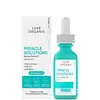What's inside
What's inside
 Key Ingredients
Key Ingredients

 Benefits
Benefits

 Concerns
Concerns

 Ingredients Side-by-side
Ingredients Side-by-side

Water
Skin ConditioningAlcohol Denat.
AntimicrobialButylene Glycol
HumectantIsopropyl Myristate
EmollientEthylhexyl Palmitate
EmollientNiacinamide
SmoothingGlyceryl Stearate
EmollientSilica
AbrasiveDimethicone
EmollientCetearyl Alcohol
EmollientPolyglyceryl-3 Methylglucose Distearate
EmulsifyingPEG-100 Stearate
Behenyl Alcohol
EmollientButyrospermum Parkii Butter
Skin ConditioningPhenoxyethanol
PreservativeCarbomer
Emulsion StabilisingTriethanolamine
BufferingAllantoin
Skin ConditioningCaprylhydroxamic Acid
Isopropyl Palmitate
EmollientCaprylyl Glycol
EmollientBoswellia Serrata Resin Extract
SmoothingDisodium EDTA
Salicylic Acid
MaskingMelaleuca Alternifolia Leaf Extract
PerfumingHippophae Rhamnoides Fruit Extract
Skin ConditioningGlycolic Acid
BufferingUlmus Davidiana Root Extract
Skin ConditioningPueraria Lobata Root Extract
HumectantPinus Palustris Leaf Extract
TonicOenothera Biennis Flower Extract
AstringentCapryloyl Salicylic Acid
ExfoliatingZinc PCA
HumectantMandelic Acid
AntimicrobialGluconic Acid
Lactic Acid
BufferingSodium Hydroxide
BufferingDenatonium Benzoate
MaskingLactobionic Acid
BufferingDioscorea Japonica Root Extract
Skin ConditioningViola Mandshurica Flower Extract
AntioxidantAloe Barbadensis Leaf Extract
EmollientLaminaria Japonica Extract
Skin ProtectingChrysanthemum Parthenium Extract
Skin ConditioningCalendula Officinalis Flower Extract
MaskingMentha Piperita Leaf Extract
Skin ConditioningThymus Vulgaris Extract
PerfumingAnthemis Nobilis Flower Extract
MaskingOriganum Vulgare Leaf Extract
Skin ConditioningUrtica Dioica Extract
AstringentSodium Hyaluronate Crosspolymer
HumectantSodium Hyaluronate
HumectantSalvia Officinalis Leaf Extract
CleansingLippia Citriodora Leaf Extract
AstringentBellis Perennis Flower Extract
Skin ConditioningGlycerin
HumectantEthylhexylglycerin
Skin ConditioningCitric Acid
BufferingWater, Alcohol Denat., Butylene Glycol, Isopropyl Myristate, Ethylhexyl Palmitate, Niacinamide, Glyceryl Stearate, Silica, Dimethicone, Cetearyl Alcohol, Polyglyceryl-3 Methylglucose Distearate, PEG-100 Stearate, Behenyl Alcohol, Butyrospermum Parkii Butter, Phenoxyethanol, Carbomer, Triethanolamine, Allantoin, Caprylhydroxamic Acid, Isopropyl Palmitate, Caprylyl Glycol, Boswellia Serrata Resin Extract, Disodium EDTA, Salicylic Acid, Melaleuca Alternifolia Leaf Extract, Hippophae Rhamnoides Fruit Extract, Glycolic Acid, Ulmus Davidiana Root Extract, Pueraria Lobata Root Extract, Pinus Palustris Leaf Extract, Oenothera Biennis Flower Extract, Capryloyl Salicylic Acid, Zinc PCA, Mandelic Acid, Gluconic Acid, Lactic Acid, Sodium Hydroxide, Denatonium Benzoate, Lactobionic Acid, Dioscorea Japonica Root Extract, Viola Mandshurica Flower Extract, Aloe Barbadensis Leaf Extract, Laminaria Japonica Extract, Chrysanthemum Parthenium Extract, Calendula Officinalis Flower Extract, Mentha Piperita Leaf Extract, Thymus Vulgaris Extract, Anthemis Nobilis Flower Extract, Origanum Vulgare Leaf Extract, Urtica Dioica Extract, Sodium Hyaluronate Crosspolymer, Sodium Hyaluronate, Salvia Officinalis Leaf Extract, Lippia Citriodora Leaf Extract, Bellis Perennis Flower Extract, Glycerin, Ethylhexylglycerin, Citric Acid
 Reviews
Reviews

Ingredients Explained
These ingredients are found in both products.
Ingredients higher up in an ingredient list are typically present in a larger amount.
Disodium EDTA plays a role in making products more stable by aiding other preservatives.
It is a chelating agent, meaning it neutralizes metal ions that may be found in a product.
Disodium EDTA is a salt of edetic acid and is found to be safe in cosmetic ingredients.
Learn more about Disodium EDTAGlycerin is already naturally found in your skin. It helps moisturize and protect your skin.
A study from 2016 found glycerin to be more effective as a humectant than AHAs and hyaluronic acid.
As a humectant, it helps the skin stay hydrated by pulling moisture to your skin. The low molecular weight of glycerin allows it to pull moisture into the deeper layers of your skin.
Hydrated skin improves your skin barrier; Your skin barrier helps protect against irritants and bacteria.
Glycerin has also been found to have antimicrobial and antiviral properties. Due to these properties, glycerin is often used in wound and burn treatments.
In cosmetics, glycerin is usually derived from plants such as soybean or palm. However, it can also be sourced from animals, such as tallow or animal fat.
This ingredient is organic, colorless, odorless, and non-toxic.
Glycerin is the name for this ingredient in American English. British English uses Glycerol/Glycerine.
Learn more about GlycerinWater. It's the most common cosmetic ingredient of all. You'll usually see it at the top of ingredient lists, meaning that it makes up the largest part of the product.
So why is it so popular? Water most often acts as a solvent - this means that it helps dissolve other ingredients into the formulation.
You'll also recognize water as that liquid we all need to stay alive. If you see this, drink a glass of water. Stay hydrated!
Learn more about Water